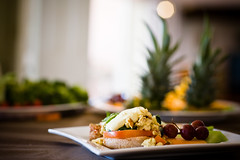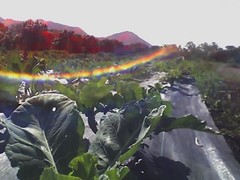Thursday, May 08, 2008
A few words from Phiya Kushi
Monday, March 31, 2008
Brown Rice Cream Power
Brown rice cream is rice that is cooked for a long time with significantly more water than normal, and then the cream is squeezed from the pulp through cheesecloth to leave a very nourshing and comforting result. It's beneficial for people who are having trouble swallowing, digesting, or who are very sick and weak.
Because our friend was so weak, we had to feed him spoonfuls of the brown rice cream. The change was amazing! He became more coherent in speech, more active and aware, and then slept more soundly when he fell asleep. The nurse's aid came in to take his blood pressure, and this had normalized since the previous measurements which had been too low.
It was truly remarkable to see!
Friday, March 28, 2008
can't imagine life without whole foods
What's for breakfast?
Blessed to live in Hawaii
Hijiki Tartlet
Thursday, March 20, 2008
Friday, March 14, 2008
Frankenfish in the ocean
Toxic Plastic Soup
The University of Hawaii is set to launch an expedition with the goal of confirming a new trash "continent" in the Pacific Ocean. A vast expanse of floating trash has been collecting in the Pacific Ocean into a mass that scientists are now referring to as the Great Pacific Garbage Patch. The thick mass of plastic soup, located approximately 500 miles east of California, is now reported to be twice the size of the Unites States. The collection of debris comes as no surprise to experts in this area. According to a recent report from the UN Environment Programme, on a global level, each square mile of ocean water contains an average of 46,000 pieces of floating garbage. Learn more: http://alerts.organicconsumers.org/trk/click?ref=zqtbkk3um_1-118x3236x3355345&
And a reply came in after posting the message above:
Hey Naturally,
Saw your site had previously posted about the Great Pacific Garbage Patch out in the middle of the oceanic desert so I wanted to send this along.
At VBS.tv we had read all the articles about this environmental problem but didn't see much in the way of video. So curiosity and the challenge compelled us west to the middle of the Pacific Ocean to show what other people had only been writing about. We go all the way out ( 2 straight days on a sail boat) expecting to see a floating dump, looking for our money shot that will make us famous.
Here's the bad news, there is no money shot. What people don't get is that it's not really a patch and it's not really an island, both of which you might be able to contain and control. No, what we found is much worse. It's like a gigantic toxic stew and it's a big big problem that we need to pay attention to now.
The series starts on April 7th on VBS. We decided to go against the conventional wisdom that internet video is for those with short attention spans, and are rolling out 12 episodes.
You can go here to view the trailer for Toxic: Garbage Island and follow the series - http://www.vbs.tv/shows/toxic/garbage-island/
The host, Thomas Morton, will be on CNN Headline News to discuss Toxic: Garbage Island: April 12th & 13th @ 7:30pm, 9:30pm and 12:30am if you find your self flipping through the channels.
If you have any questions, let me know.
Rory Ahearn
VICE/VBS.tv
All 12 Parts of Garbage Island + Special Bonus Episode on Bisphenol A on VBS.tv
Hey Earth Lovers,
Pardon the mass email. Well, it's been a long journey out into the Great Northwest Garbage Patch in the Pacific Ocean but our environmental oceanic Odyssey is complete. Now the hard part starts.
With Earth Day still recent but fading fast I just wanted to email you all and let you know that all 12 parts of Toxic: Garbage Island, plus a special bonus episode are up now on VBS. Education and awareness are the first steps we need to make if we are going to right this situation, people should not be able to claim ignorance anymore.
It's our mess and now we have to clean it up. The series has been a huge success thanks to all of you who talked about it or posted. Heck, we even got on CNN and ABC News.
You can watch all 12 episodes by going here: Toxic: Garbage Island on VBS.tv - http://www.vbs.tv/shows/toxic/garbage-island/
We also did a special bonus episode. An interview with Frederick Vom Saal, Ph.D on Bishpenol A which has been all over the news as of late with plastic drinking containers. Super disturbing.
Interview on Bisphenol A with Dr. Frederick Vom Saal - http://www.vbs.tv/video.php?id=1519713792
Want to see Thomas on CNN? - http://www.cnn.com/video/#/video/bestoftv/2008/04/14/ntm.garbage.island.cnn
Any recap post or just telling your friends to check out it would be awesome.
Thanks for watching. Don't forget to recycle,
Rory Ahearn
VICE/VBS.tv
Consumer Alerts: Kind of shocking
A newly released study commissioned by the Organic Consumers Association (OCA) and overseen by environmental health consumer advocate David Steinman (author of The Safe Shopper's Bible), revealed the presence of the undisclosed carcinogenic contaminant 1,4-Dioxane in leading shampoos, body washes, lotions and other personal care and household cleaning products claiming to be "natural" or "organic". The study results, to be released this weekend at the Natural Products Expo in California, are already sending shockwaves through the "organic" and "natural" body care industry. Laboratory tests showed that products certified under the USDA National Organic Program DID NOT contain this toxin, but most of the best selling personal care products claiming to be "organic" (but not USDA certified) contained the cancer-causing ingredient. All leading self-proclaimed "organic" brands have at least a few individual "certified organic" ingredients, but for most of these top-selling brands, the product, as a whole, is not USDA organic certified, thereby allowing the presence of synthetic toxins. Similar studies have revealed the presence of this toxin in conventional personal care products, but this is the first study indicating the presence in misleadingly labeled "organic" and "natural" products. Learn more: http://www.organicconsumers.org/comingclean.cfm
_______________________________
CONSUMER TIP OF THE WEEK:HOW TO AVOID 1,4-DIOXANE IN YOUR PERSONAL CARE PRODUCTS
Some of the products found to contain 1,4-Dioxane: JASON Pure Natural & Organic, Giovanni Organic Cosmetics, Kiss My Face, Nature’s Gate Organics (see a full list of OCA's study results here)
Remember that just because a personal care product labels itself with the words "organic" or "certified organic" doesn't mean it meets any specified organic standards.
Look for products that are certified under the USDA National Organic Program (or a similar German program) and products that bear the "USDA Organic" seal.
Search product labels for ingredients with the following in their names to avoid products containing 1,4-Dioxane: myreth, oleth, laureth, ceteareth, any other eth, PEG, polyethylene, polyethylene glycol, polyoxyethylene, or oxynol.
In general, avoid products with unpronounceable ingredients to be sure to avoid synthetic toxins and carcinogens.
Thursday, February 28, 2008
A day with breakfast at the local organic farm
Upon arriving, I got a tour of the various fields and was amazed to see that the workers were out harvesting the salad greens with scissors. All of the harvesting (pounds upon pounds of greens) are hand-harvested very gently and lovingly, rather than with machinery. My friend and I picked some red russian kale, lacinato kale, scallions, red radishes, hakurai (white round) radishes, daikon, carrots, and oranges as ingredients in our meal.
At 7:00 a.m. each day, the group gathers at the main building, and while holding hands in a circle, they do a skin tingling Hawaiian chant before going back out into the fields for more planting and/or harvesting. After working in the field, everyone comes back to the packing shed and they begin delicately washing, drying, and bagging all these amazing greens.
In the meantime, I was in the kitchen making breakfast. My kitchen consisted of a big industrial size frig, a sink, and 3-burner propane gas camping stove, and was open on 3 sides to the farm, so while I was cooking, I was thoroughly enjoying the view of the stunning mountain ranges surrounding me, listening to the birds singing, and smelling the food as it pressure cooked, simmered, boiled, and sauteed.
By about 9:30 a.m, breakfast was ready. We had a pressed salad with pumpkin seed dressing, shiitake and daikon miso soup, carrot muffins, pressure cooked brown rice, apple and raisin compote, and a very satisying sauteed tempeh and onion dish that my friend made.
One of the student interns who was enjoying the meal said, "I usually eat a lot more, but I didn't go back for more food. I'm so full with just one plate! Why?" and I just thought it had to do with the food having more life and energy than he was used to (i.e. spam musubi or loco moco).
From there, we cleaned up, talked story for a while, and then I headed into the packing shed to help everyone. All in all, it was a great day.
Friday, February 22, 2008
David Beckham and Macrobiotics
http://www.youtube.com/watch?v=UF9Pahclz3Y
Local Seasonal Fruit
Eat More Kale
Friday, January 11, 2008
Local Organic Farm 2
Local Organic Farm
Friday, December 07, 2007
Verne Varona’s Top Ten Sugar Craving Strategies
1. REDUCE SALT & PRODUCTS WITH SALT The need for dietary salt from natural sources (sun-dried sea salt) is dependent on several factors; a lack of salt can cause fatigue, stimulate a desire to overeat and often result in a craving or animal protein. However, with the availability of good quality sea salt, miso paste, tamari soy sauce and natural pickles, it's quite easy to overdose. Thirst and a craving for sweet foods is one of the most reliable indicators of excess dietary salt.
2. REDUCE ANIMAL PROTEINThe standard four basic food group propaganda was force-fed to the American public along with the myth that animal protein should be a dietary staple. The meat and potatoes mentality has to re-think its philosophy since established research shows excess animal protein can lead to colon and prostate cancer. If this applies to you eat less in volume (2 to 4 ounce servings) and limit it to three to four times per week (maximum), as opposed to daily.
3. REDUCE FOOD VOLUME Overeating leads to fatigue and sluggishness. This makes a stimulant like sugar (or coffee) more appealing. Eating more frequently will allow you to reduce overeating with a minimum of effort.
4. EAT MORE FREQUENTLY THROUGHOUT THE DAY One of the most common reasons for sugar cravings--especially at night. By skipping meals or waiting long periods you stop supplying your blood with glucose. The blood sugar drops and by the time you finally get around to eating, you're going nuts for simple sugar. You're also likely to end up overeating or craving something fatty as a compensation for sugar. Initially, don't wait more than 31/2 to 4 hours between meals.
5. AVOID EATING PRIOR TO BED If your body's digesting when it requires much needed rest, you'll require more sleep, dream excessively and find it difficult awakening with alertness. Good deep sleep will result in wide-awake days. Eating to close to bedtime creates a groggy awakening craving the stimulation of sugar (or caffeine) the following morning. Eat a light evening dinner at least 21/2 to three hours before retiring.
6. AVOID SUGAR This might sound obvious, however, continuing to eat simple sugars results in a falling blood sugar. This stimulates a need for more sugar and the cycle continues. Even though fruit is a simple sugar, switching to fruit instead of sugar is a good first step. Eat the skin of the fruit as well since fiber slows blood sugar elevation.
7. EXERCISE MODERATELY, BUT CONSISTENTLY Daily aerobic exercise will increase circulation and strengthen will power. Brisk walking, biking, light jogging, etc. naturally increases sensitivity to the effects of sugar. Try to get 20 to 30 minutes of some type of pleasurable exercise at least 5 times per week. Enjoy this. It should not be a chore.
8. EMPHASIZE NATURAL WHOLE COMPLEX-CARBOHYDRATES If your daily diet is includes whole grains (brown rice, oats, millet, barley, etc.), vegetables (roots, greens and round vegetables such as squashes, cabbages, etc.) as a primary fuel, you'll find you automatically crave less sugar. Emphasizing sweet vegetables such as carrots, cooked onions, corn, cabbage, parsnips, squashes, etc., adds a natural sweetness to meals. Introduce some sea vegetables (aka "seaweeds") for much needed minerals to enrich blood.
9. DON'T SUPPRESS FEELINGS This doesn't mean you have to broadcast every feeling--only those that matter and to those who really matter to you. Food indulgence, especially with sweets, is a convenient way to anesthetize feelings. Sugar can consume you with sensory pleasure, temporarily providing mental relief from whatever might be stressful. However, sweets can hinder energy levels and mental clarity so in the long run your emotional coping ability becomes compromised.
10. BEWARE OF PSYCHOLOGICAL TRIGGERS The many psychological associations we connect with food have a powerful influence. Beware of family associations, movie rituals, familiar restaurants, childhood habits, etc.
Naturally Sweet Holidays
Nutty Caramelcorn (Macrojacks)
8 cups organic popped corn (around 1/2 cup before popping)
¼ cup almonds, chopped
¼ cup walnuts, chopped
¼ cup peanuts
¼ cup raisins
½ to 2/3 cup brown rice syrup
Olive oil (to oil the baking pan and pop the corn)
Preheat oven to 350 degrees. Place all ingredients into a large bowl and mix well until the rice syrup covers everything nicely. If the rice syrup is too sticky, heat it up first or it will crush the popcorn as you are trying to mix the ingredients. Transfer mixture to a lightly oiled baking sheet and spread out in a single layer. Bake for 8 to 10 minutes, and watch carefully so that it does not burn. Let cool to harden, about 5 minutes, before removing with a spatula. Soak baking sheet in hot water to remove the hardened sweetener, about 5 minutes.
Utensils: pan to pop corn, baking sheet, wooden spoon, measuring cups
Variations: Substitute puffed or flaked cereals, or crumbled rice cakes for part of the popcorn.
Tuesday, October 09, 2007
Improving Allergies with a Macrobiotic Diet
When a person becomes ill, it means some imbalance can be found in the body. Our bodies can only stand so much before they break down. When we eat things that are unsuitable for us, the body reacts with sneezes, coughing, hives, mucus, diarrhea, vomiting, skin eruptions and anaphylactic shock in its effort to dispel toxins. The more toxins built up, the stronger the reaction will be.
The good news is that balance can be restored by changing one’s diet.
An excessive intake of the following items can increase a person’s susceptibility to allergies:
- dairy products
- oily and greasy foods
- poultry and eggs (especially for skin allergies)
- refined flour
- fruits and their juices (especially tropical fruits)
- sugar, honey, soft drinks
- fish (especially blue-skin fish for skin allergies)
- raw foods
- spices
- drugs and chemicals
Here are several suggestions for allergies:
- Minimize oatmeal, flakes, and grits. Avoid baked flour products, especially those with yeast. If you crave bread, have some natural sourdough or unleavened bread on occasion. Stay away from pies, cakes, and pastries for now.
- Have miso soup or miso rice every day.
- Avoid raw foods in the beginning except good quality natural pickles.
- Minimize intake of oil, using it only for lightly sautéed vegetables once or twice a week, if you really desire it. Use dark sesame oil.
- Initially reduce your intake of beans and bean products, using smaller portions of the “regular use” beans (azuki, lentil, and chickpeas) only. Among bean products, tofu is the best to use.
- Be especially light on all salt seasonings including shoyu, miso, and umeboshi.
- Generally avoid nuts and nut or seed butters. Roasted seeds are alright to use.
- It’s best to stay away from fruit initially. If you crave it, eat a little bit of cooked, temperate climate, dried fruit. If you crave a sweet taste, first try satisfying it by eating naturally sweet vegetables such as squash, carrots, parsnips, rutabaga, etc. You can prepare delicious desserts using grain-based sweeteners, chestnuts, and other non-fruit ingredients. Then, if you still crave an even sweeter taste, eat the fruit.
- Minimize animal food, take only white meat fish, once or twice a week at the most and only if you truly desire it.
- Avoid spices (including mustard, pepper, and curry).
- Make sure to include both lightly cooked foods and well-cooked foods daily.
- Good digestion is very important, so it is imperative to chew very well.
- Pay particular attention to vigorously scrubbing your body with a hot damp towel once a day for good circulation.








